Mental Health Employee Survey: A Complete Guide [+ 10 Questions]

Ignoring employee mental health leads to bad consequences for everyone.
And it’s not just an empty statement. It’s happening all around us, all the time.
Take a senior leader in a big corporation who overlooked clear warning signs - both personal and from the team - for months.
The result? Severe burnout, which didn’t just take out the leader but triggered a domino effect: more employees became ill, projects stalled, and key clients left.
It didn’t end there. The aftermath of this neglect resulted in:
- team morale that has dropped
- top performers who resigned
- significant expenses from turnover, onboarding, and reputational damage
Yikes.
This case powerfully illustrates how expensive it can be when mental health is overlooked for too long.
So, why does this continue to happen in businesses today?
As our partner, Daniela Kiel, a clinical psychologist and consultant, puts it:
Mental health is invisible – until it explodes. Many organizations focus only on what can be measured and tracked. But emotional exhaustion or psychological strain doesn’t show up on a KPI dashboard.
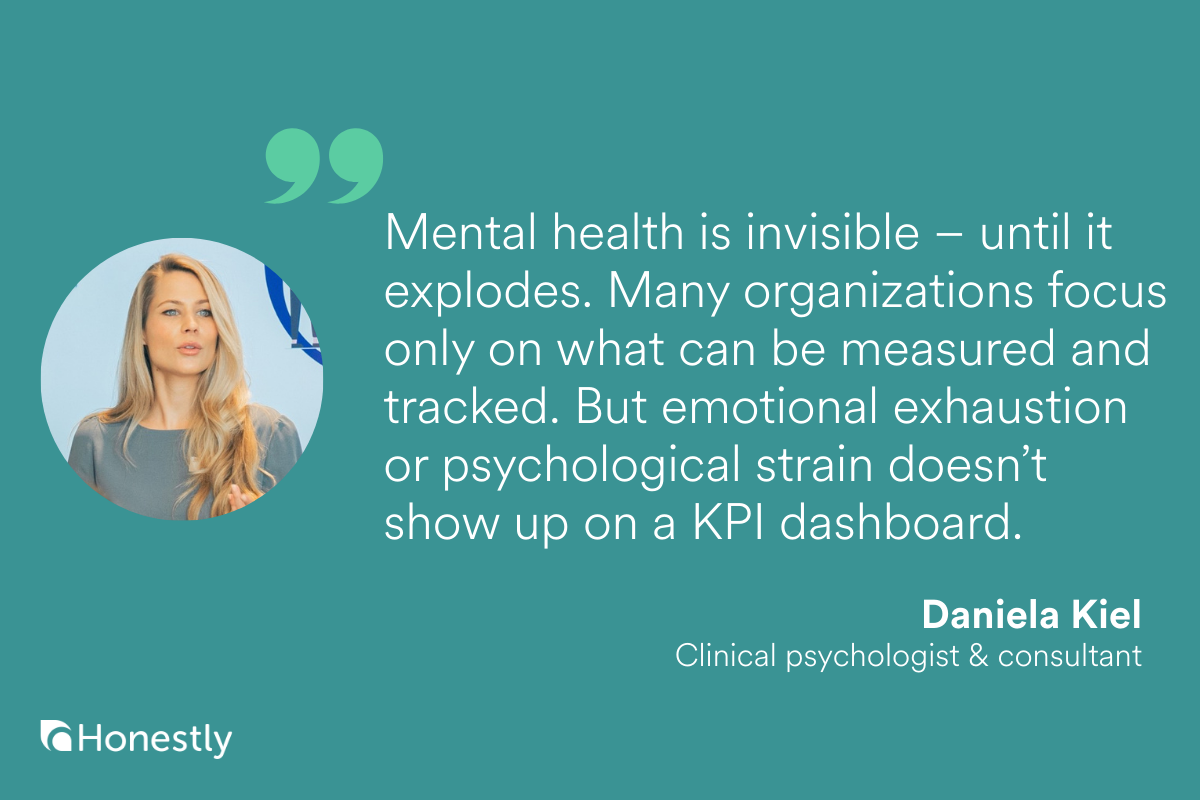
From her perspective, what’s needed is real cultural change.
As leaders, we must learn to take emotional dynamics as seriously as financial ones.
And yes, that’s uncomfortable – but essential.
“Because what gets suppressed doesn’t disappear. It just comes back louder” - adds Daniela.
In this article we will talk about mental health employee survey as one of the tools to:
- listen to your employees and monitor their state of mind regularly
- turn insights into actions before it’s too late
Here’s what we’ll cover:
So… What is a Mental Health Survey, Exactly?
A mental health survey is basically a way to check in with your people to see how they’re really doing, beyond just their to-do lists and performance reviews.
It’s a tool that gives employees space to share what’s going on with their well-being at work: what’s supporting it, what’s draining it, and what they wish was different.
It’s not about diagnosing anyone or playing therapist. It’s about listening better.
When done right, a mental health survey helps you:
- Spot early signs of stress, burnout, or overwhelm
- Understand how supported (or not) people feel
- Create a culture where it’s okay to say: “I’m not okay”
- Make real improvements to how your company supports mental health
Think of it as a pulse check for your workplace’s emotional climate: quiet, honest, and incredibly valuable.
When to Run a Mental Health Employee Survey?
Short answer? Way more often than once a year.
People break up.
They experience loss.
They become parents.
They burn out.
They get depressed.
They struggle with anxiety.
Mental health isn’t something that only matters at review time or after an all-hands meeting.
It shifts with what’s happening inside your company and in people’s lives.
These surveys are your chance to check in regularly, not just react when things go sideways.
Here are a few moments when it really makes sense to check the pulse:
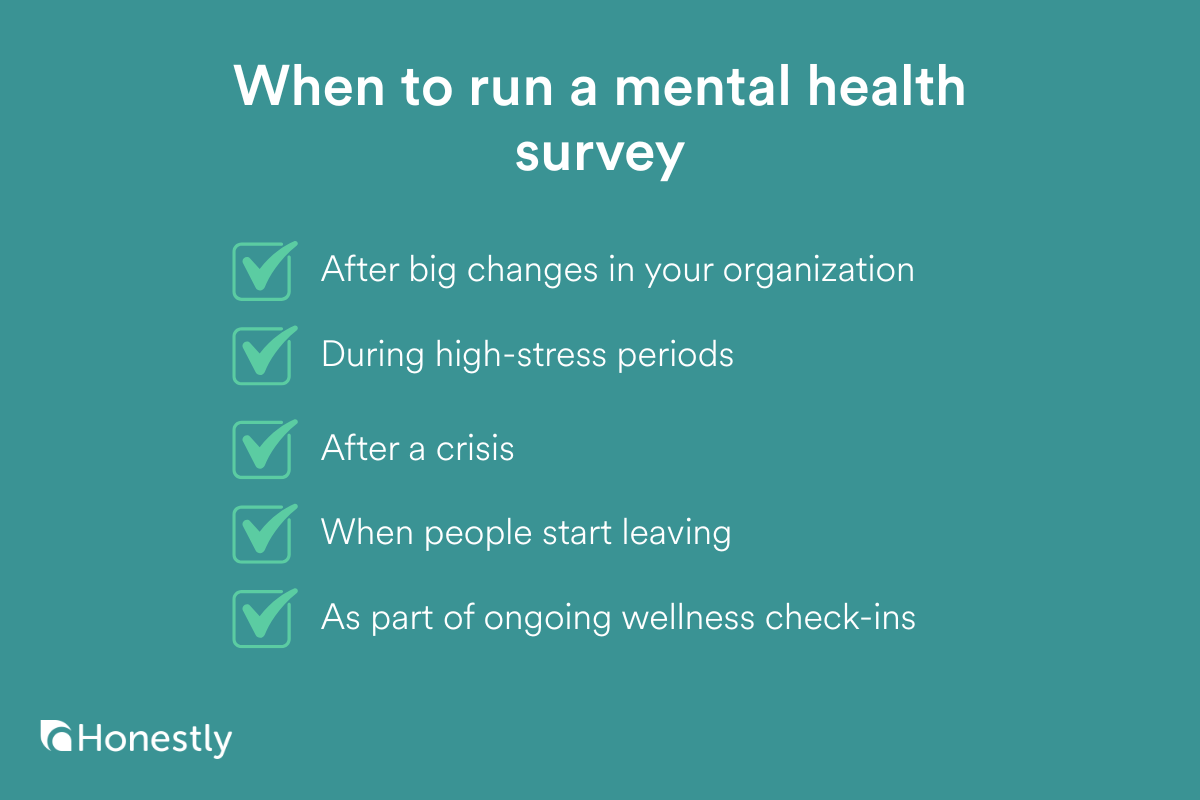
After big changes in your organization
Think leadership shake-ups, re-orgs, mergers, or acquisitions. Even if things are “strategically sound,” big shifts like these can leave people feeling anxious, unclear about their roles, or just plain unsettled.
A mental health survey helps you hear what’s under the surface, before it snowballs.
During high-stress periods
Got a big launch coming up? A huge audit? End-of-quarter crunch? These moments often push people to their limits.
A survey helps you spot who’s nearing burnout so you can offer support before they hit a wall.
After a crisis
Layoffs, public backlash, product fails: whatever the crisis, the ripple effects stick around.
A mental health check-in gives people space to process, and gives you the insight to respond in a caring, grounded way.
When people start leaving
If your top people are quitting and you’re not sure why, mental health might be part of the story (even if no one’s saying it out loud).
A survey can surface burnout, stress, or emotional exhaustion that’s flying under the radar.
As part of ongoing wellness check-ins
Sometimes, nothing huge is happening and that’s actually the perfect time to ask.
Regular surveys (even just a few questions) help catch issues early, show you care, and build trust.
What if Your Leadership isn’t Convinced?
Running a mental health survey is easy, it’s what comes after that’s scary.
That’s why leaders can be hesitant about it. It’s not out of indifference, but because of a deeper concern: loss of control.
There’s a fear that a survey might “open a can of worms” or lead to findings they don’t feel prepared to act on.
Our partner Daniela told us:
One executive once asked me, “What if the results show that people are really struggling – what do we do then?” That question reveals the core issue: it’s not the survey itself that’s scary, but the responsibility it creates.
Daniela’s advice is pure gold:
Don’t try to convince with data alone. Ask the deeper question:
Do we really want to leave mental wellbeing to chance – or are we ready to understand, so we can lead with intention?
Also, start small. A short, anonymous pulse check or a pilot within one department can be a low-risk entry point.
Positive experiences build trust and often shift mindsets more effectively than any presentation.
For Daniela, mental health surveys aren’t about losing control – they’re about gaining clarity. They’re not a threat. They’re a compass.
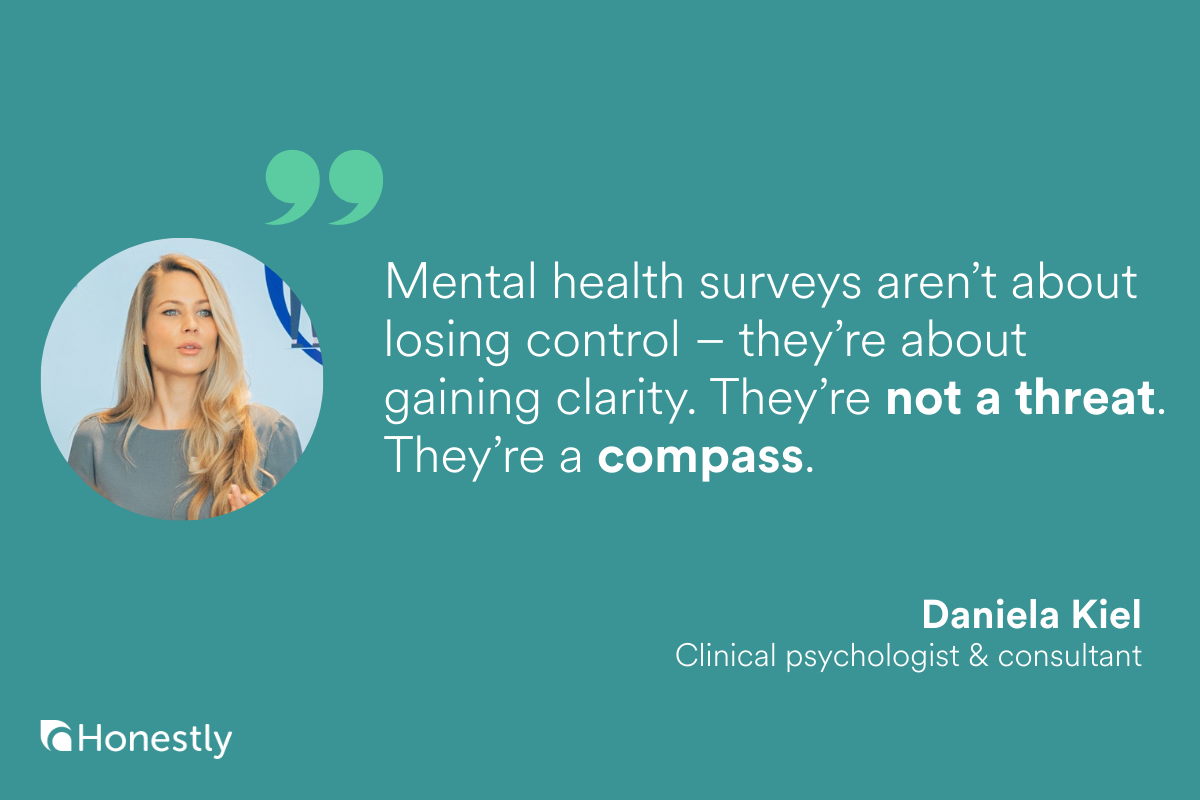
10 Mental health survey questions
Here are 10 example questions you can consider asking both your leaders and employees.
For Team Leaders
Leadership plays a huge role in shaping how safe, supported, and mentally healthy a workplace feels.
Our 5 example questions below are designed specifically for leaders, not to evaluate or pressure, but to spark reflection, surface honest insights, and build stronger habits around supporting mental well-being.
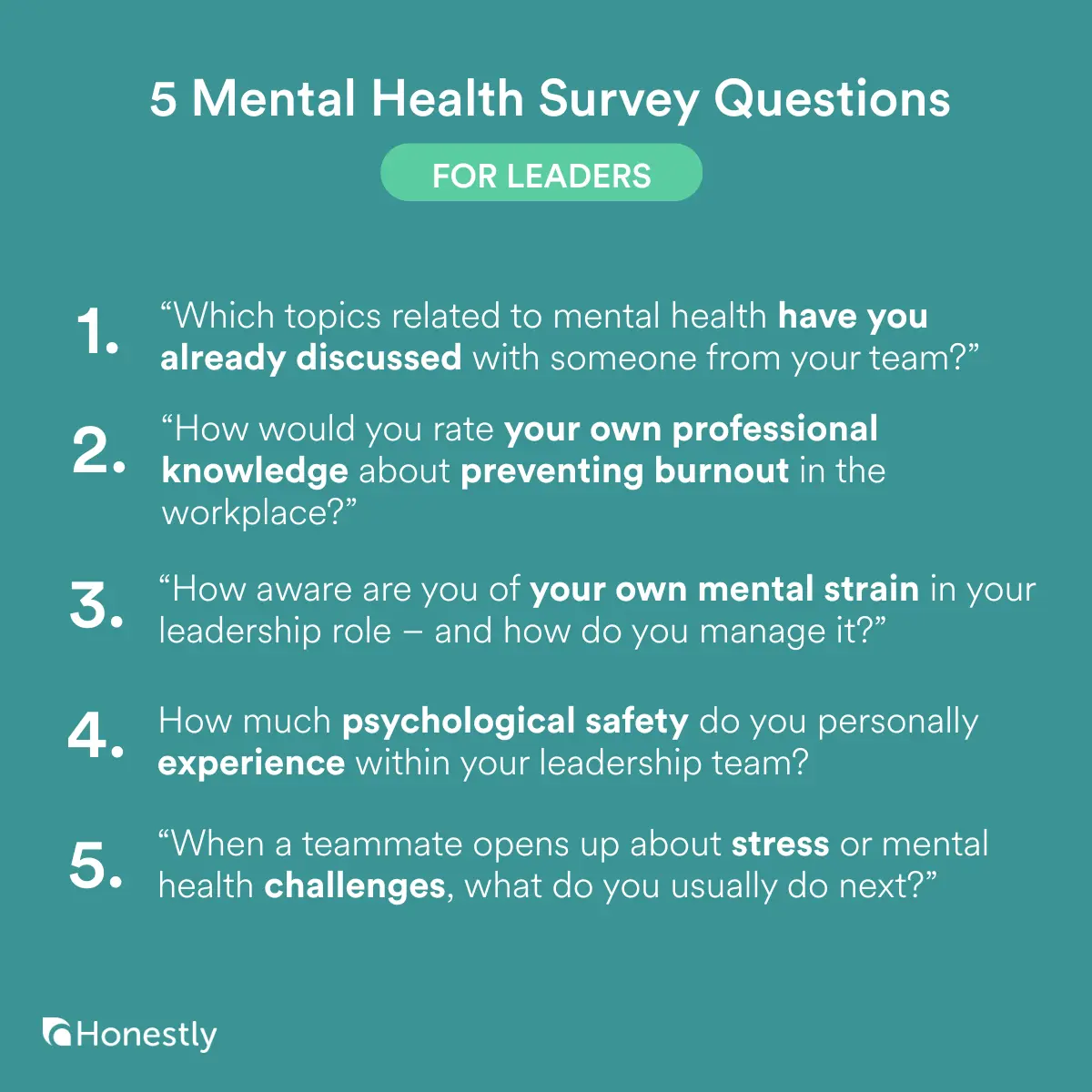
They touch on how open conversations are, how confident leaders feel supporting others, and how well they’re managing their own stress.
Use them to kickstart internal conversations, leadership check-ins, or as part of a broader well-being strategy.
Question #1: “Which topics related to mental health have you already discussed with someone from your team?”
Why ask this?
This question helps you get a feel for how open the team culture is when it comes to talking about mental health and what’s actually being talked about.
It’s not about tracking who said what, but more about seeing if these conversations are happening at all, and where there might still be some awkward silence.
What insights it gives:
- Tells you if mental health is part of the day-to-day conversation or still off-limits
- Shows which topics people feel okay bringing up (stress? burnout? boundaries?)
- Helps you figure out where to build more comfort or confidence around talking openly
Question #2: “How would you rate your own professional knowledge about preventing burnout in the workplace?”
Why ask this?
This one gently checks whether managers or team leads actually know what to look out for when it comes to burnout, and how to help prevent it. It’s not about shaming anyone. It’s about seeing who might need a bit more guidance or training in this area.
What insights it gives:
- It shows whether your leaders feel confident spotting and handling burnout
- Highlights where you might need to do more education or share better tools
Question #3: “How aware are you of your own mental strain in your leadership role – and how do you manage it?”
Why to ask it
Self-leadership is the foundation of good leadership – yet often overlooked.
This question is about hitting pause and getting leaders to actually check in with themselves. Being in charge often means powering through stress without stopping to notice it. Or feeling like you can’t show it.
This invites a bit of honesty and self-awareness around how much weight they’re carrying, and what they’re doing (or not doing) to cope.
What insights it gives
- It opens up honest conversations about leadership burnout
- Helps you see who might need support, but isn’t saying it out loud
- Encourages a culture where taking care of yourself is seen as part of being a good leader
Question #4: How much psychological safety do you personally experience within your leadership team?
Why to ask it
Culture starts at the top. If leaders don’t feel safe, it’s unlikely to create sustainable change.
This checks whether leaders themselves feel like they can speak up, admit mistakes, ask for help, or push back without worrying they’ll get shut down or judged.
If that safety isn’t there at the top, it’s hard for it to trickle down to the rest of the company.
What insights it gives
- Shows how open and trusting your leadership culture really is
- Highlights whether leaders feel like they can be human with each other
- Can surface silent tension, fear of conflict, or lack of real collaboration
Question #5: “When a teammate opens up about stress or mental health challenges, what do you usually do next?”
Why to ask it
This question brings it into the real world: when someone shares that they’re not okay, how do leaders actually respond? It’s one thing to say we support mental health and another to know what to do in the moment. This helps you understand if leaders feel confident stepping into those moments with care, or if they’re unsure, freeze up, or quietly move on.
It’s not a judgment. It’s a window into where they’re at and how supported they feel when others open up to them.
What insights it gives
- Highlights whether support is reactive, proactive, or missing entirely
- Shows how equipped leaders feel to respond in real conversations
- Can guide what practical tools or coaching might help build confidence in these situations
For employees
Mental health is personal, but how supported people feel at work plays a huge role in how they manage it day to day.
Our 5 questions are designed to help you understand what your employees are experiencing. Not just in terms of stress or workload, but in how safe, seen, and supported they actually feel.
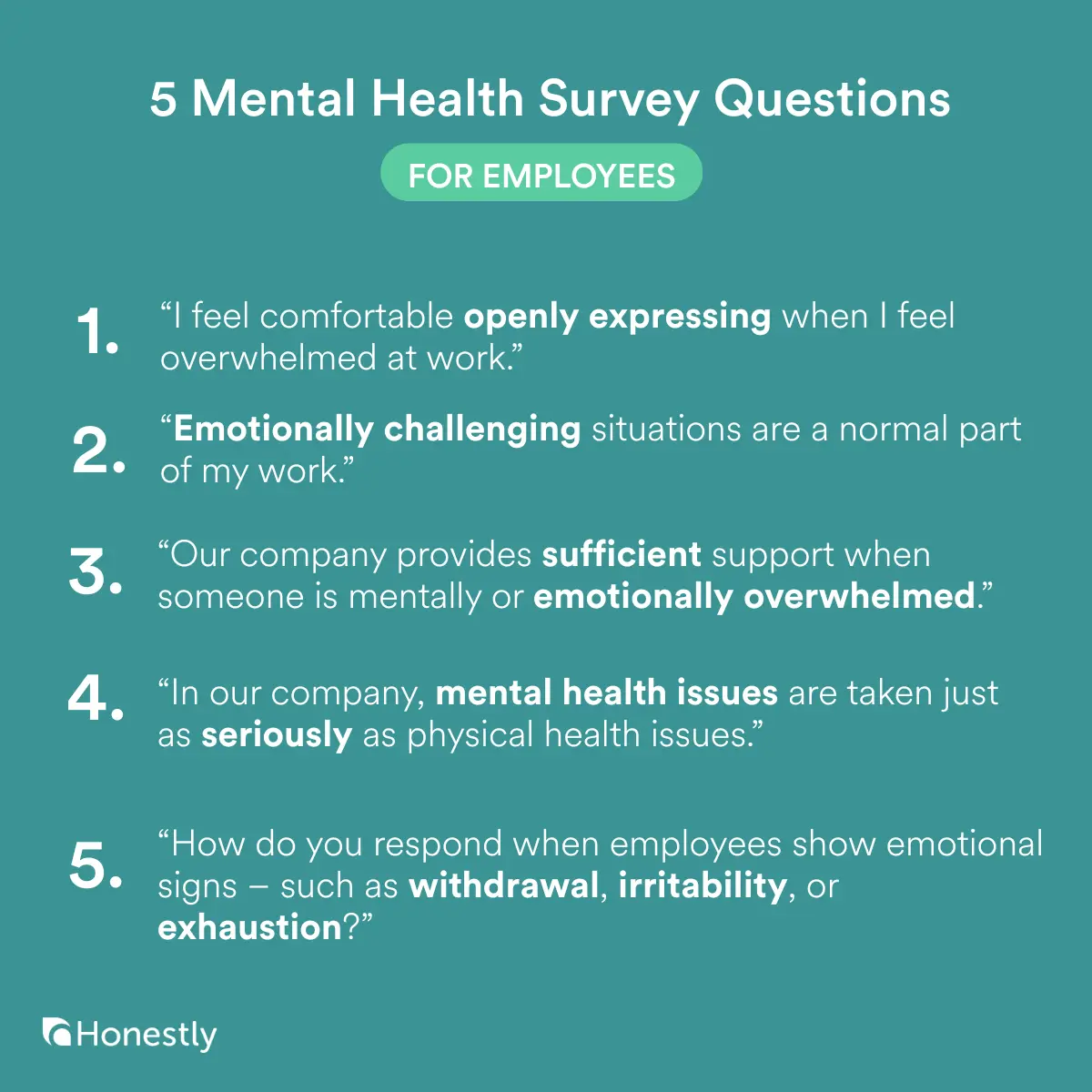
From emotional strain to trust in leadership, these questions go deeper than surface-level satisfaction.
They’re designed to spark real conversations, surface blind spots, and guide you toward building a culture where people can take care of their mental health without fear or stigma.
Question #6: “I feel comfortable openly expressing when I feel overwhelmed at work.”
Why to ask it
This one is all about psychological safety. Do people actually feel okay saying, “Hey, I’m hitting a wall,” without worrying they’ll be judged or seen as weak? It’s a big deal, especially in fast-paced or high-pressure environments where the default is to just push through.
What insights it gives
- It tells you if people feel safe being real about their limits
- Highlights trust (or lack of it) in teams or with managers
- Helps spot places where the culture might need more openness or support
This kind of question can surface the gap between “we say we support mental health” and “people actually feel safe speaking up.”
Question #7: “Emotionally challenging situations are a normal part of my work.”
Why to ask it
This one helps you understand if people are regularly dealing with things that are emotionally draining, like tough customer interactions, handling crises, or just high-pressure situations. It doesn’t mean something’s wrong, but it tells you how emotionally heavy the day-to-day can be.
What insights it gives
- It can show you which roles carry a heavier emotional load
- Helps you know where extra support or training might help
- It’s a good starting point to check if people feel prepared for the emotional side of their work
Question #8: “Our company provides sufficient support when someone is mentally or emotionally overwhelmed.”
Why to ask it
This one gets to the heart of whether people feel like the company actually shows up when things get hard. Not just with nice words, but with real, useful support.
It’s about more than having a mental health policy. It’s whether folks feel backed up when life hits hard or stress piles up.
What insights it gives
- Tells you if your mental health support is actually landing or just ticking a box
- Helps spot gaps in your current resources or how well people know about them
- Can guide where to invest next. Is it better communication, manager training, or new support tools?
Question #9: “In our company, mental health issues are taken just as seriously as physical health issues.”
Why to ask it
This question checks if your team really sees mental health being treated with the same level of care and urgency as, say, a broken leg or the flu. It’s one thing to have it in the handbook and another thing to actually walk the talk.
What insights it gives:
- Shows whether people feel mental health is truly respected
- Highlights gaps between policy and practice
- Helps you spot if stigma or double standards still exist
Question #10: “How do you respond when employees show emotional signs – such as withdrawal, irritability, or exhaustion?”
Why to ask it
Mental health often speaks quietly. Recognizing it is key to effective support.
This question gets at something really important: when someone on the team is clearly not okay, what actually happens? Do managers freeze up, brush it off, or lean in with empathy? It’s a great question to surface how confident or prepared people feel when mental health shows up in real, human ways.
What insights it gives
- Tells you how emotionally aware and equipped your managers or peers feel
- Spots where folks might need training or support around mental health conversations
- Can highlight cultural norms: does your team lean toward empathy or avoidance?
How to Run a Mental Health Survey - Best Practices
Mental health is a sensitive and deeply personal topic.
This means how you run your survey matters just as much as what you ask.
If you want honest feedback, trust is key. Here’s how to approach it in a way that feels safe, respectful, and actually useful.

- Start with safety: anonymity is non-negotiable
- Use a trusted external survey tool like Honestly that guarantees anonymity. This isn’t just about tech. It shows people you’re serious about protecting their privacy.
- Be super clear that no one’s going to be singled out or “found out” based on their answers. Reassure folks that honesty won’t come back to bite them.
- Keep It focused, friendly, and thoughtful
- Know your “why.” What are you trying to learn or improve? Let that shape how you design the survey.
- Don’t overload it. Short and focused surveys get better participation. Think snack-sized, not three-course dinner.
- Mix it up: use both multiple-choice and open-ended questions. Some things can’t be said in a checkbox.
- Ease people in. Start with the easier questions, then gently move into more personal topics once they’ve warmed up.
- Communicate like you mean it
- Be clear about why this matters. Let people know this isn’t just another HR checkbox. It’s about creating a healthier, more supportive workplace.
- Tell them what you’re going to do with the feedback. People are more likely to share if they know their voice actually leads to something.
- Get visible support from leaders and managers. If people see their higher-ups backing this, it sets the tone: “We care, and we’re listening.”
- Handle the data with care
- Share results in a way that protects everyone’s privacy. No calling out specific teams or individuals.
- Don’t generalize one person’s experience to a whole group. Use the data to spot patterns, not point fingers.
- Treat the results as a mirror. They’ll help you see what’s working, what’s missing, and where the culture needs some love.
- Actually do something with the results
- Don’t let the survey be a dead end. Share back what you learned and what you’re planning to do about it.
- If possible, involve employees in next steps. Maybe through workshops, feedback sessions, or collaborative action planning.
- Show them that their input matters. Not just with words, but with real change.
- Be clear on who you’re talking to and why
- Think ahead: is this survey meant for everyone, or just for leaders? Are you trying to solve a specific problem, or get a general read on the culture?
- Tailor the questions (and your follow-up actions) to the group you’re targeting. One size doesn’t fit all here.
Frequently Asked Questions About Mental Health Surveys
What are the most appropriate and respectful questions to ask in a mental health survey?
Ask questions focused on well-being, stress, and support. Avoid medical terms or diagnosing language. Keep tone neutral and empathetic. For example: “Over the past two weeks, how often have you felt overwhelmed at work?”
How do we measure mental well-being without making employees feel exposed or uncomfortable?
Use anonymous, non-clinical language. Keep questions general and offer Likert-scale responses. For example: “I feel supported by my manager when I’m dealing with stress or personal challenges.”
What’s the right frequency for checking in on employee mental health?
You could start with quarterly, then adjust based on culture and need. Use short pulse surveys for frequent check-ins. For example: “How manageable has your workload felt over the past two weeks?”
How do we communicate a mental health survey so employees see it as support, not surveillance?
Be transparent: explain purpose, privacy, and how data will be used to improve well-being, not to evaluate performance. Your message could say: “We care about your well-being. This anonymous survey helps us understand how to better support you and create a healthier workplace.”
How can we analyze and act on mental health survey results without violating confidentiality?
Aggregate data, use anonymized segments (team size > 5), and avoid cross-referencing sensitive info.
What indicators should we be tracking to spot burnout or chronic stress early?
Watch for low energy, disengagement, emotional exhaustion, and feelings of ineffectiveness. For example: “I feel emotionally drained after a typical workday.”
Are there validated frameworks or scales we can use to assess mental health in a workplace setting?
Yes. PHQ-4 (for anxiety/depression), WHO-5 (well-being), and the Copenhagen Burnout Inventory are common. Customize to fit your workplace tone. Here’s a sample question (from WHO-5): “I have felt cheerful and in good spirits.”
How do we ensure that mental health survey responses lead to real support, not just data collection?
That’s the most critical part! Share themes back with employees, outline action steps, and follow through. Involve leaders and managers. Keep everyone updated, regularly.
What trends should we be watching across industries or demographics when it comes to workplace mental health?
Rising burnout among Gen Z, remote worker isolation, caregiving stress, and demand for flexibility. You could compare this data internally by team, role, and tenure.
Conclusion: It Starts With Listening
When it comes to supporting mental health at work, there’s no quick fix. No silver bullet. No “one-size-fits-all” program.
But if there’s one thing every company can (and should) start with, it’s this: listening.
As clinical psychologist and consultant Daniela put it:
The most important first step? Listening. Before launching any program, companies need to understand how people truly feel – honestly, anonymously, and consistently.
Mental health surveys aren’t just checkboxes or HR trends.
Done right, they’re a way to tune in to the emotional heartbeat of your organization. They show employees that you care enough to ask and that you’re ready to act on what you hear.
Daniela shared a powerful example from a company she worked with.
The survey didn’t uncover a crisis. It uncovered a quiet drain. People weren’t falling apart, but they were running on empty.
What stood out most,” she said, “was how difficult it was for people to set boundaries, say ‘no,’ and clearly express their own needs.
The insight? Burnout wasn’t about chaos, it was about depletion.
The company didn’t throw a meditation app at the problem. Instead, they introduced training on self-leadership, emotionally intelligent communication, and handling tough conversations. All paired with real changes to how work was structured.
The real shift didn’t come from the survey itself,” Daniela said. “It came from the courage to look honestly at the results and take action.
So wherever your company is right now, whether you’re just opening up the conversation or ready to dig deep, know this:
Mental health at work isn’t about perfection. It’s about progress, honesty, and the willingness to show up for your people in a way that actually makes a difference.
Start with a question.
Really listen to the answers.
Then, do something about them.

